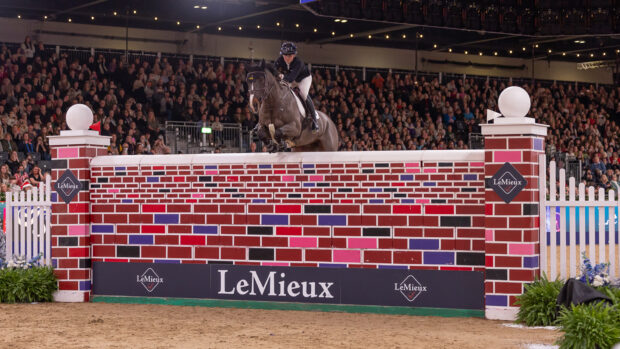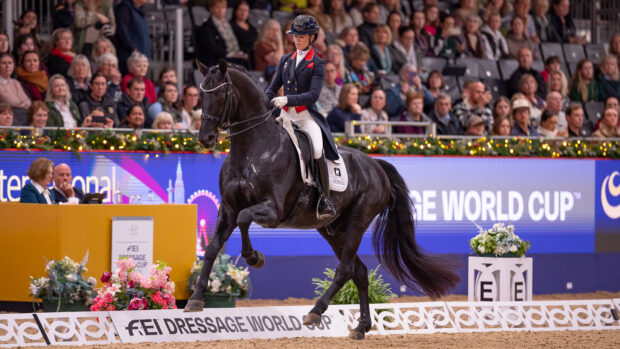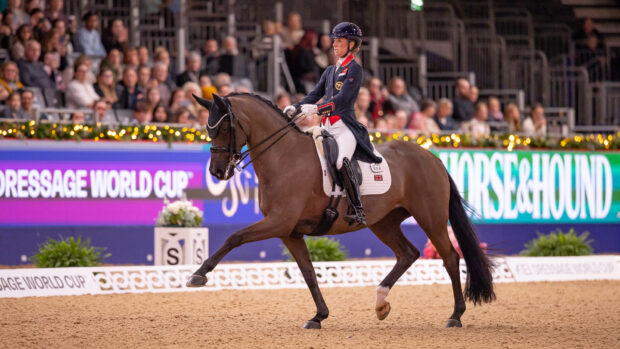Caroline Moore, a former five-star eventer who enjoyed great success during her time as British Eventing national under-18 coach and junior team coach, explains how you can use this gridwork exercise to encourage your horse to become straighter and quick on his feet. But, the horse in this video – which was filmed six years ago – is none other than the current European eventing champion and 2023 Badminton winner Lordships Graffalo, who is heading to the Paris Olympics next week with Ros Canter, who is also riding ‘Walter’ in this video.
Caroline says that while this is a fairly advanced exercise, it can be adapted to make it suitable for young horses.
The aims of the exercise are to:
- Develop confidence with a narrow fence
- Develop rider steering aids
- Help to train horse’s jumping technique
- Hold a line
- Develop straightness
Caroline explains this exercise:
“You jump into this exercise over an upright, followed by one non-jumping stride to a skinny. This teaches the horse to stay straight immediately. From that narrow fence we move onto a spread fence — I’m using an oxer that is square and encourages a good round shape. This is directly followed by another skinny on one stride to again establish straightness. The final element of this exercise is a bounce, which encourages the horse to read the pattern we’re asking him to negotiate and to improve their sharpness coming out of an exercise.
“This is a multi-directional exercise, so we can use the bounce coming in to start instead. The important thing when riding this initially is that the rider keeps their eyesight looking straight ahead, and if the horse backs off, they ride really positively, with a secure lower leg so that you’re in a good posture to land and ride forward to come out of the exercise with plenty of confidence.
“Riding a straight line through this exercise is imperative. As you come in, you must jump the first fence dead in the middle, keeping the inside leg very secure to maintain the line.
“You can then add another fence on a turn from the final element and then jump it either way. This makes it quite an advanced exercise and if you are jumping the single fence first, it’s crucial to make a good turn onto the line of fences. You need to keep hold of your outside rein, always looking to the next fence and with the weight down your inside heel to help keep your horse balanced.
“Once your horse has confidence jumping through this exercise at a small height, you can increase the size of the fences.
“You need to really concentrate on thinking about your horse’s outside shoulder coming through the turn first.”
Caroline’s points to be aware of:
- Losing balance and rhythm on the turn
- Drifting at the first fence
- Maintaining energy while jumping down the line
- Praise and reward
You might also be interested in:

Lordships Graffalo – meet Ros Canter’s supreme star who eats tack, licks cars and loves a cuddle

Ros Canter triumphs at Badminton with huge winning margin on ‘ultimate event horse’

Don’t get the cold shoulder: how to tackle a shoulder brush across country
Caroline Moore, former five-star eventer and British Eventing national under-18 coach and junior team coach, explains how to tackle shoulder

Subscribe to Horse & Hound magazine today – and enjoy unlimited website access all year round
Stay in touch with all the news in the run-up to and throughout the Paris Olympics, Royal International, Burghley and more with a Horse & Hound subscription. Subscribe today for all you need to know ahead of these major events, plus online reports on the action as it happens from our expert team of reporters and in-depth analysis in our special commemorative magazines. Have a subscription already? Set up your unlimited website access now




